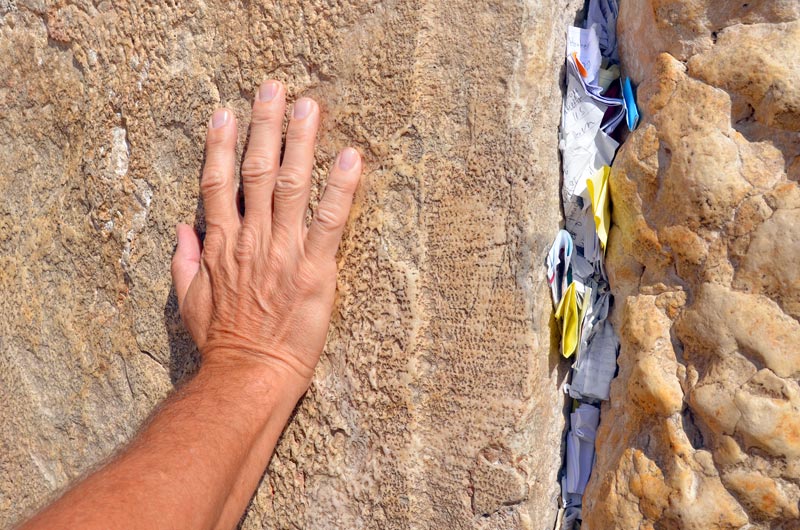Jerusalem: Sacred Memories in Stone
In the Old City of Jerusalem.
This week, we’re traveling to the Middle East, to Jerusalem, to the sacred site that is at the very center of spiritual history for the three main Western religions—Christianity, Judaism, and Islam. Jerusalem is a city of ancient stones, holding the memory of humankind’s search for the sacred, the holy, the blessed, and the memory of the blood that has been shed in the name of God.
To those of the Jewish faith, Jerusalem is the Holy City, the City of David and the location of Solomon’s Temple, and the capital of the nation of Israel. To Christians, it is the site of the Last Supper, the crucifixion, and the resurrection. For Muslims, it is the site of Muhammad’s ascension to heaven.
When David, the king of Israel and Judah, turned the city into his capital in 955 BC, he moved the Ark of the Covenant (the shrine that held the stone Tablets of the Law that Moses received at Mount Sinai) there and named the city Jerusalem, the “City of Peace.”
It has been a place of turmoil and religious contention ever since. But nothing can change the inherent sacredness that all recognize there.
King David erected a temple on the site of Mt. Moriah because of an ancient tradition that said the bare rock on top of the mount was where the underworld and the upper world met, where Abraham had been ready to sacrifice his son Isaac, and where Jacob, the patriarch, had a visionary dream as he slept upon a stone pillow.

The Tower of David, also known as the Citadel, stands near the entrance to the Old City of Jerusalem.
David’s son, King Solomon, finished building the temple in 957 BC, but the Babylonians soon took over Jerusalem and destroyed this first temple and exiled the Jews. Not long after, the Persians conquered Babylon and the Jews returned to Jerusalem, completing a Second Temple in 525 BC. Then for the next five centuries, Jerusalem changed hands from one ruling empire to another—from the Greeks and Egyptians to the Romans, with the Second Temple being destroyed in 70 AD.
The only remnant of King Solomon’s temple was the Western Wall, a retaining wall for the temple, which is known today as the Wailing Wall.

The Wailing Wall
Here at the Wailing Wall, Jews from around the world touch the stones that hold the memory of the repeated destruction of their holy temples. They leave messages and prayers to God in the cracks between the stones. The wall’s holiness derives from its nearness to the Temple Mount, where the “Holy of Holies” stood (the innermost sanctum of the first temple that housed the Ten Commandment tablets).

The Roman Emperor Hadrian then built a temple to the Roman god Jove (Jupiter) on the site, which was destroyed when the Roman Empire became Christian. The Empress Helena and her son Constantine built the Church of the Holy Sepulchre, marking the spot of the resurrection of Jesus.

The Church of the Holy Selpulchre
During this era when churches were being built, Christian pilgrimages began to Jerusalem, until the Persians invaded and destroyed churches and monasteries.
Today, Christians walk the fourteen stations of the Cross, the Via Dolorosa, the “Way of Sorrows”—the route Jesus walked while carrying the heavy burden of the wooden cross on which he would hang—as well as the shrine of the Ascension at the Mount of Olives, the garden of Gethsemane, and the site of the Last Supper at Mt. Zion.
As they walk the Via Dolorosa, pilgrims touch the ancient stones of the walls of the Old City. Feel the sorrow and the blessing of touching the same stones that bore witness to the final walk and ultimate triumph of Jesus in Jerusalem.

At one of the stations of the cross along the Via Dolorosa
Twenty-four years later, Muslims captured Jerusalem and built the Dome of the Rock on the site of the two previous Jewish temples and the Roman temple to Jove (Jupiter). They venerated the Temple Mount as the spot of the Prophet Muhammad’s “Night Journey,” a mystic journey in which Muhammad rode on a winged steed in the company of Archangel Gabriel, who took Muhammad to the pinnacle of the rock where Muhammad ascended a golden ladder through seven heavens and stood in the presence of Allah. For Muslims, this shrine, and the adjacent al-Aqsa Mosque, is the third holiest place of Islam, after Medina and Mecca.

The Dome of the Rock
In Jerusalem, the cobbled streets and ancient stone walls hold the memories of the complex historical politics that have built and destroyed monuments to the divine over the centuries, and of the spiritual longing and love we all seek.
The city of Jerusalem is a powerful epicenter of history and energy. It’s palpable when you visit there. You can feel the centuries of history and conflict and worship. It’s hard not to.
And while it’s a bit more difficult to feel that energy from the comforts of your own home. It’s not impossible. You just need to learn to travel through the Astral realm, which you can learn to do with our bestselling Astral Wisdom course.
Once you master this skill, you can tap into all the world’s energetic vortexes such as Glastonbury, Mt. Shasta, and Jerusalem.

